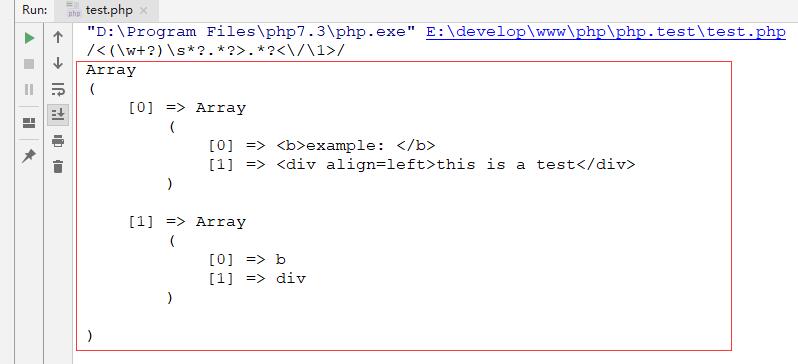PHP生成正则表达式的类
正则表达式,写起来还是比较费劲的,于是封装个类,初稿,抛砖引玉。
class Pattern { public $pattern = ''; public static function init(){ return new static(); } public function start($char){ $this->pattern .= '^' . $char; return $this; } public function end($char){ $this->pattern .= $char . '$'; return $this; } //匹配次数 public function count($range = null){ if(is_array($range)) $range = implode(',', $range); if(is_numeric($range) || strpos($range, ',') ) $range = '{' . $range . '}'; $this->pattern .= $range; return $this; } public function match($pattern, $get = true){ $this->pattern .= '(' . ($get ? '' : '?:'). $pattern . ')'; return $this; } //转义 public function escape($char){ $this->pattern .= '\\' . $char; return $this; } public function append($string, $comment = null){ $this->pattern .= $string; //$this->pattern .= $string . ($comment ? '(?#'. $comment .')' : ''); return $this; } public function flush(){ $pattern = $this->pattern; $this->pattern = ''; return $pattern; } public static function help(){ $help = <<<'help' [\b] => 单词边界 [\B] => 非单词边界 [\cx] => x 指明的控制字符,值必须为 A-Z 或 a-z 之一 [\d] => 数字,[0-9] [\D] => 非数字,[^0-9]。 [\f] => 换页符,等价于 \x0c 和 \cL [\n] => 标识一个八进制转义值或一个向后引用。如果 \n 之前至少 n 个获取的子表达式,则 n 为向后引用。否则,如果 n 为八进制数字 (0-7),则 n 为一个八进制转义值。 [\r] => 回车符,等价于 \x0d 和 \cM [\s] => 空白字符,等价于 [\f\n\r\t\v] [\S] => 非空白字符,等价于 [^\f\n\r\t\v] [\t] => 水平制表符,等价于 \x09 和 \cI [\v] => 垂直制表符。等价于 \x0b 和 \cK [\w] => 字母、数字、下划线,等价于 [A-Za-z0-9_] [\W] => 非字母、非数字、非下划线。等价于 [^A-Za-z0-9_] [\xn] => 匹配某个十六进制表示的字符,值必须为确定的两个数字长。\x41B 表示 AB [\num] => 对所获取的匹配的引用,"(.)\1" 匹配两个连续的相同字符 [\nm] => 标识一个八进制转义值或一个向后引用。如果 \nm 之前至少有 nm 个获得子表达式,则 nm 为向后引用。如果 \nm 之前至少有 n 个获取,则 n 为一个后跟文字 m 的向后引用。如果前面的条件都不满足,若 n 和 m 均为八进制数字 (0-7),则 \nm 将匹配八进制转义值 nm [\nml] => 如果 n 为八进制数字 (0-3),且 m 和 l 均为八进制数字 (0-7),则匹配八进制转义值 nml。 [\un] => n 是四个十六进制数字表示的 Unicode 字符 help; echo $help; } //正向查找 public function forward($string, $positive = true){ $this->pattern .= '(?' . ($positive ? '=' : '!') . $string . ')'; return $this; } //反向查找 public function backward($string, $positive = true){ $this->pattern .= '(?<' . ($positive ? '=' : '!') . $string . ')'; return $this; } public function exec($mode = null){ $mode = $mode ? $mode : ''; $pattern = '/' . $this->pattern . '/' . $mode; return $pattern; } //条件查找 public function condition($condition, $string){ $this->pattern .= '(?(' . $condition. ')'. $string .')'; return $this; } } $html = "<b>example: </b><div align=left>this is a test</div>"; $pattern = Pattern::init()->append('<(\w+?)', '标签名') ->append('\s*?', '空格') ->append('.*?>','属性') ->append('.*?', '内容') ->append('<\/\1>', '回溯引用标签名') ->exec(); echo $pattern . "\n"; preg_match_all($pattern, $html, $out); print_r($out);






【推荐】国内首个AI IDE,深度理解中文开发场景,立即下载体验Trae
【推荐】编程新体验,更懂你的AI,立即体验豆包MarsCode编程助手
【推荐】抖音旗下AI助手豆包,你的智能百科全书,全免费不限次数
【推荐】轻量又高性能的 SSH 工具 IShell:AI 加持,快人一步
· 如何编写易于单元测试的代码
· 10年+ .NET Coder 心语,封装的思维:从隐藏、稳定开始理解其本质意义
· .NET Core 中如何实现缓存的预热?
· 从 HTTP 原因短语缺失研究 HTTP/2 和 HTTP/3 的设计差异
· AI与.NET技术实操系列:向量存储与相似性搜索在 .NET 中的实现
· 10年+ .NET Coder 心语 ── 封装的思维:从隐藏、稳定开始理解其本质意义
· 地球OL攻略 —— 某应届生求职总结
· 周边上新:园子的第一款马克杯温暖上架
· Open-Sora 2.0 重磅开源!
· 提示词工程——AI应用必不可少的技术